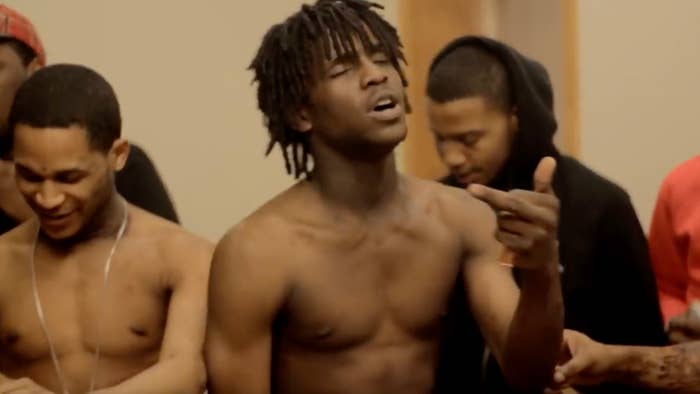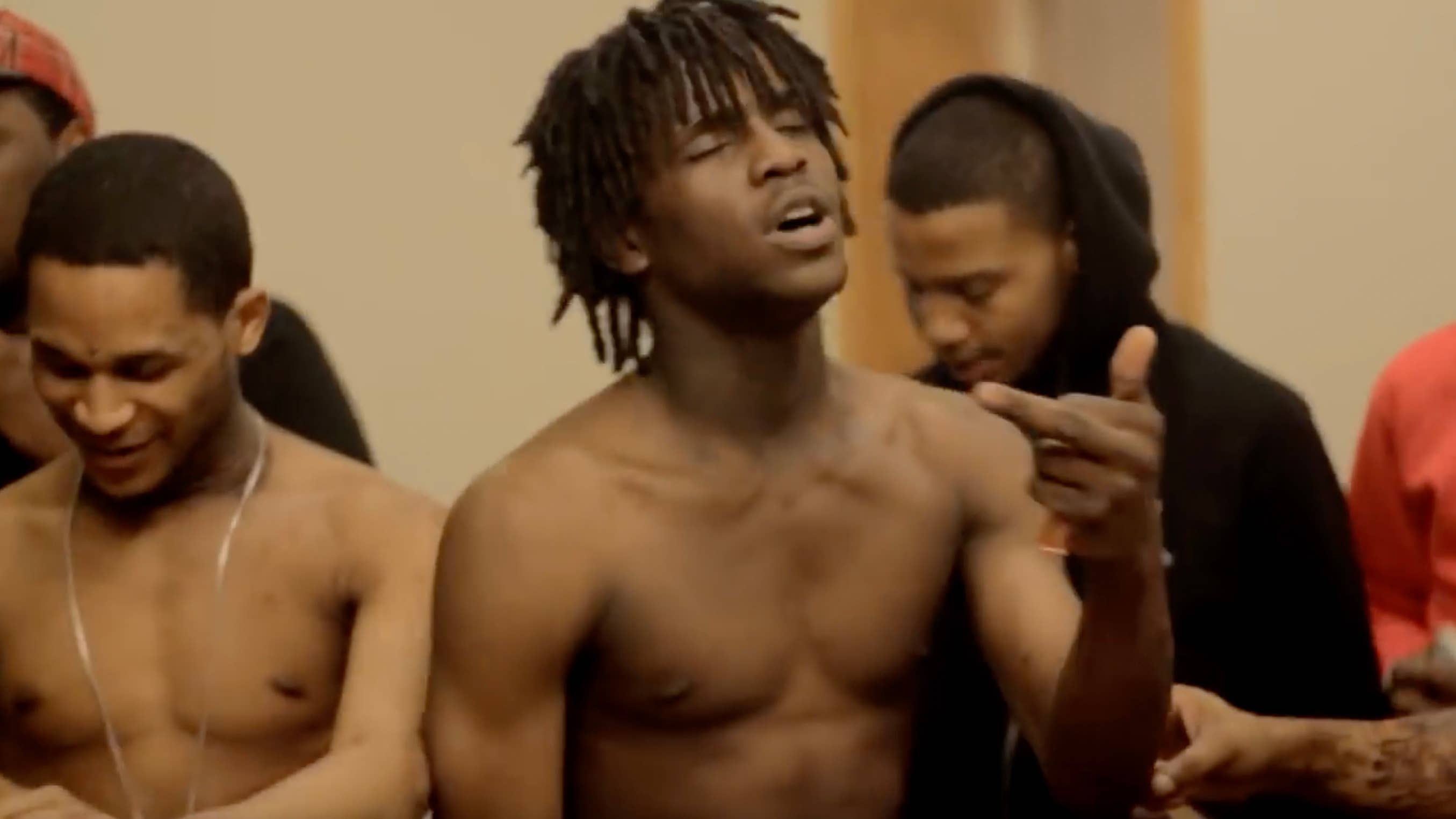
Use the tools available to you. Your work might not be perfect, but if you don’t get it out there, it’ll never be at all. If Chicago music video director DGainz, who directed Chief Keef’s “I Don’t Like,” was worried about the quality of his camera, and Chief Keef was too worried about having a traditional music video set, they wouldn’t have influenced rap videos forever with “I Don’t Like,” a bare-bones visual that set the tone for thousands of “me and the guys” videos to follow.
The music video for a breakthrough single doubles as an artist’s first commercial. A certain sect of rappers might resolve to “fake it til they make it” with rented cars, hired models, and money fluttering throughout the air—and there’s nothing wrong with that—but it’s all a production, with a “wink-wink” factor that even the artists have to acknowledge at this point. The “I Don’t Like” video carries none of that. The five-minute visual, which was released 10 years ago on March 11, 2012, is a spectacle of simplicity that encapsulates the rawness of a Chicago drill scene that has already inspired a generation of artists.
“I Don’t Like” was first uploaded to DGainz’ YouTube channel, like so many of the first Chicago drill videos. Millions of subscribers flocked to video director’s channels, giving them the power to routinely break artists, much like mixtape DJs a generation before them. And so many of the songs on those channels take after the blueprint of Chicago drill, with dark melodies, rapid-fire percussion, and innovative cadences. All three are apparent on Keef’s Back From The Dead, an album which also recently celebrated its 10-year anniversary. “Impact” is a commodity everyone claims they’ve bought in on, but “I Don’t Like’ is an undeniable demarcation point for rap history.
All paradigm-shifting works of art shirk tradition in some fashion. Out of necessity, genius, or both, someone vies to tinker with a main ingredient of a formula and opens a new path. DGainz, like A Zae Productions, and so many other directors revolutionized music videos by tearing up video treatments and letting their subjects’ charisma carry the proceedings. Parts of the “I Don’t Like” video look more like behind-the-scenes clips than actual music video scenes. Young Chop is on his computer, possibly cooking up a beat, while someone curiously looks on next to him. Some of the guys are caught talking amongst each and smoking, barely acknowledging the camera.
These scenes hammer home the idea that they’re all literal kids, still getting used to being on camera, but the visual work works. So much of rap is about selling a lifestyle. It’s about using videos to orchestrate an outsized depiction of your supposed everyday life, and DGainz realized: What’s a better sell than a candid look at how someone’s actually living? What’s a better sign of your respect than the amount of peers who show up to dance and lock arms with you?
The best part of “I Don’t Like” is how candid it feels. It’s in the way that the usually reserved Keef is lost in the rhythm of his life-changing hit, dancing like the camera’s not there. It’s in the way that they pointed at an off-camera Fredo, while Reese rapped his iconic “scary sight” lyric, not even realizing that the line would go down in history (and that he should probably be on screen). It’s in the quick snip of Keef having so much fun dancing that he falls down and his boys pick him up. We didn’t know how rare it would be to see Keef this happy—or, unfortunately, to have so many of these artists in one place. “I Don’t Like” serves as a true-to-life, pretense-free time capsule of the GBE crew.
As A Zae Production told Complex, rap stardom in the windy city was defined by YouTube views in 2012. Whoever popped up with the most views at any given moment was the man. A whole community of artists and fans were following a rubric that the major labels weren’t even up on yet. Drill artists took advantage of YouTube to upload their music to the entire world, finding a new model for rap independence that they might not have even been that cognizant of. By 2012, the music video show was a distant relic—MTV and BET were barely even playing videos on their main channels anymore. Young hip-hop consumers were more apt to run to WorldStarHipHop than 106 & Park to see the latest videos. That dynamic further empowered DGainz and other directors to make the rawest videos possible.
Culturally, Chief Keef was a glitch in the matrix. In 2012, labels hadn’t been able to sterilize him for mass appeal—and they never would. The world saw him exactly how he was.
These run-and-gun video directors didn’t have to worry about pleasing BET or MTV’s best practice departments. They didn’t have to have a storyline to hook executives. Artists could smoke, throw signs, and yes, tote prop guns, if they wanted to. Suddenly, artists didn’t have to placate labels and sign desperate deals with whoever would consider them. They could get themselves hot on YouTube and spark a bidding war—or stay independent.
There weren’t many artists so boldly taking matters into their own hands before this, but now it feels like most rappers are utilizing that model. Consider the biggest street stars of the moment: Lll Durk, G Herbo (two artists from the original drill movement), Lil Baby, Kodak Black, NBA YoungBoy, Fivio Foreign and the hundreds of artists influenced by them. All of their breakthrough moments came through videos that they independently uploaded to YouTube and caught fire with, which enabled them to sign to their labels as priorities. And most of them, like “I Don’t Like,” were low-frills videos of burgeoning stars in their element. Beyond drill artists were SoundCloud-era rappers like Juice WRLD, Ski Mask The Slump God, and Lil Pump, who also went viral with DIY videos.
The Brooklyn drill movement didn’t just take after Chicago in name—most of the scene’s biggest videos are clips of artists and their crews vibing out. The first Brooklyn drill moments, like “Gang Gang Gang,” 22Gz’ “Suburban,” Sheff G’s “No Suburban,” were conceptual descendants of “I Don’t Like.” Bobby Shmurda and GS9 preceded the official coinage of “Brooklyn drill,” but they carried the same energy sonically. And the influence is apparent in the ionic “Hot Nigga” video, where the crew let their natural star power take them viral. Bobby has said that the “Hot Nigga” director MainE FeTTi and Bobby’s friends randomly got the urge to shoot the video, and that spontaneity is a core part of the video’s appeal. Who knows if the hat toss or Shmoney dance happens in a choreographed video? The randomity of “Hot Nigga” exists in the origin stories of thousands of videos over the past decade.
The late TDott Woo gained notoriety in Brooklyn in part because of how memorably he danced in his friend’s videos. Pop Smoke and Fivio Foreign didn’t (and don’t) need to hire dancers; they already had some in the crew. To this day, from the Bronx to Brooklyn, to Toronto and the UK, video directors are taking their cameras to the block and recording drill artists, guerilla-style. Those roads lead back to videos like “I Don’t Like.”
View this video on YouTube
Chief Keef has been open about his love for Gucci Mane and Waka Flocka, and there’s no doubt that Gucci’s low-budget “In My Kitchen” video and their infamous Hood Affairs freestyle session had an effect on a young Keef, and informed some of “I Don’t Like” video. But sonically, “I Don’t Like” and the rest of the Back From The Dead mixtape carry on Brick Squad’s legacy with futuristic synths and skittering 808s. Keef also goes in his own lane on Back From The Dead, however. While Waka was a cyclonic force, and Gucci could get by on charm alone, early-era Keef armed his music with a steely menace, as displayed on songs like “I Don’t Like” and “3Hunna.” On the latter track, he mastered the art of delivering a unified, militaristic cadence with an intriguing aloofness. He could have torn through beats with precision, but he was too cool to care to. Traces of that mic approach are all over the rap game today, most notably in Detroit.
Even more noticeable is Keef’s knack for melody. Almost every hook on the mixtape comes with an anthemic earworm. He eventually stretched that format out to entire songs on Finally Rich, giving a roadmap to future melodic artists, from Lil Yachty to Lil Uzi Vert. Back From The Dead and “I Don’t Like” were a catalyst—even if they didn’t share his gritty content, they took after him stylistically, and also borrowed his DIY, run-and-gun ethos.
Culturally, Keef was a glitch in the matrix. In 2012, labels hadn’t been able to sterilize him for mass appeal—and they never would. The world saw him exactly how he was. His explosion onto the rap scene, along with fellow drill artists, represented a thinning veil between art and reality. We had seen west coast artists as the faces of gang epidemics before, but Keef seemed immersed in the violent backdrop of his music in a way that Dr. Dre and Ice Cube weren’t. Back From The Dead, after all, was a reference to rumors that he had been killed by police after an infamous shootout. The fact that it was plausible spoke for so much, as did the prop guns in “I Don’t Like,” which were still a rare sight in music videos.
Maybe the rise of the drill scene would have happened differently (and more responsibly) if either Durk, Herbo, or Reese was the one who blew first. But Keef’s enigmatic presence further drew people to him, and hence, further into voyeurism of Chicago. Years later, fans follow the biomythography of young artists, who, like Keef, were charismatic and talented, but completely uninterested with assimilating into the industry, and had various troubles that fans could spectate from the comfort of their home. These artist’s despondency with the idea of change or adaptation is a social statement on the cultural gulf between two Americas. Keef, and Chicago drill, were the catalyst for it all.
Who knew a video director would be able to show up to a video set with no plan, work with a bunch of amateurs who had never been on camera before, tell them to wild out, and come out with gold? Before “I Don’t Like,” few did. Ten years later, we’re thankful for all of their genius.



